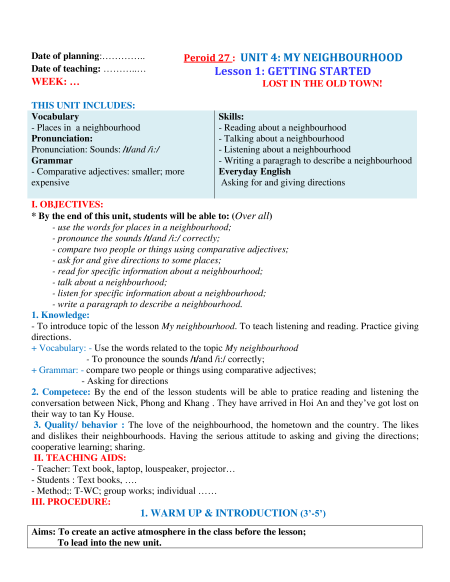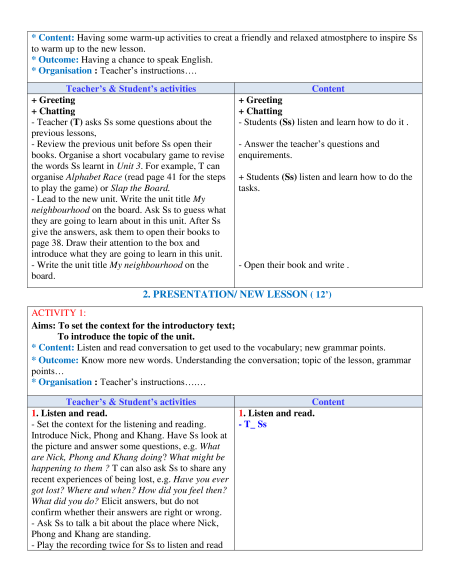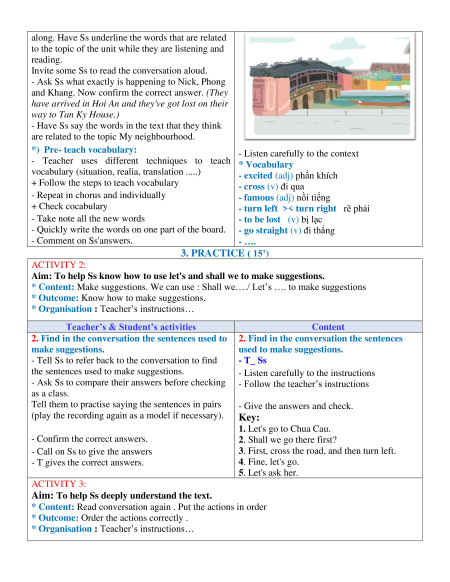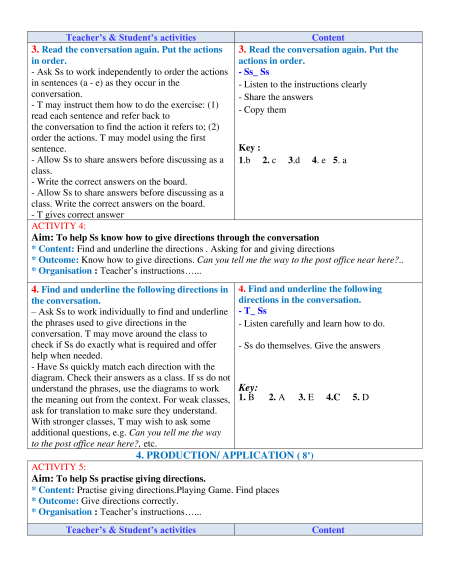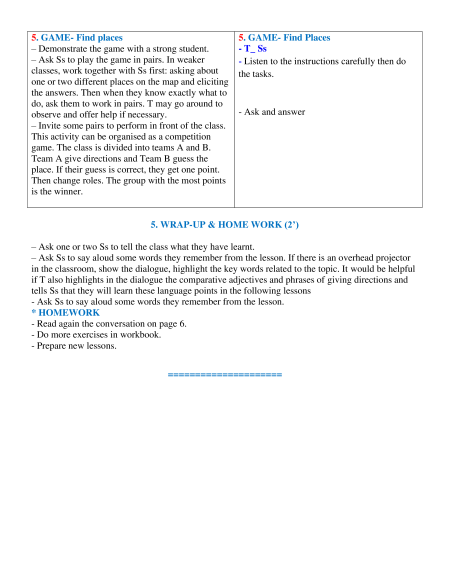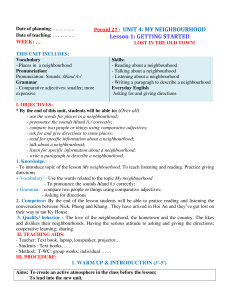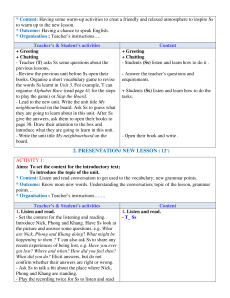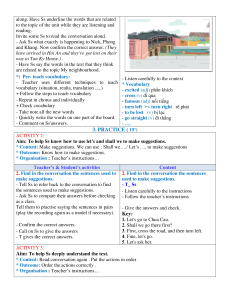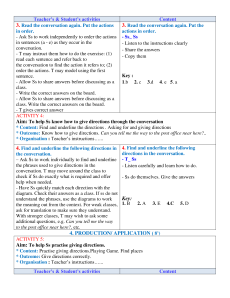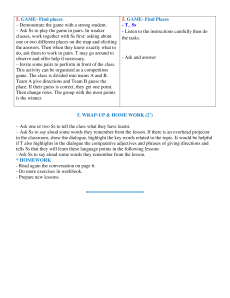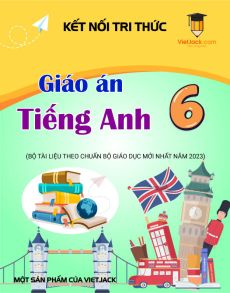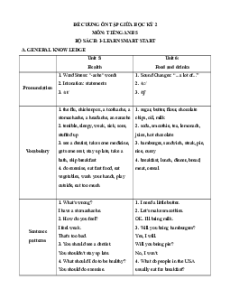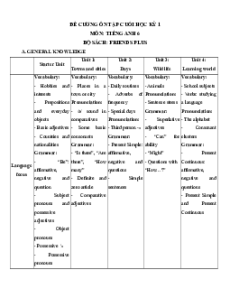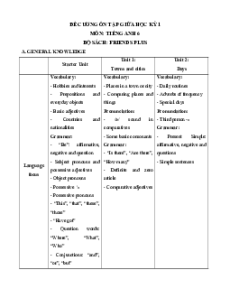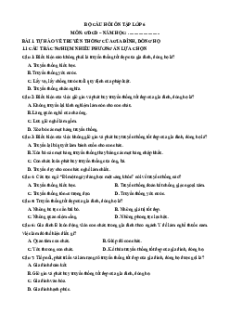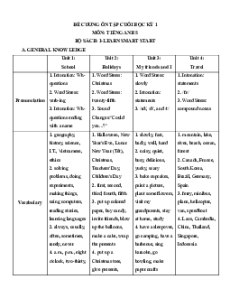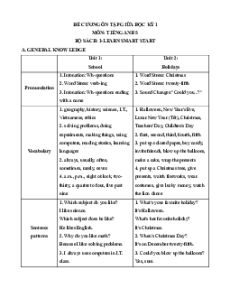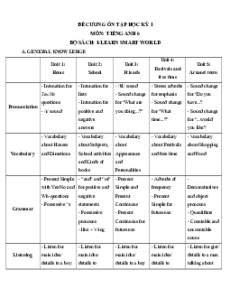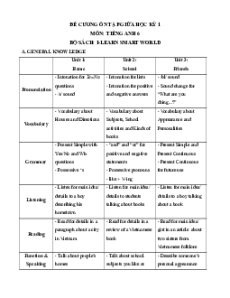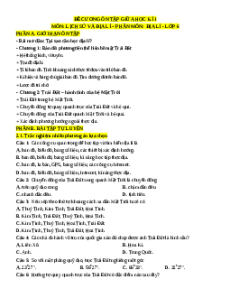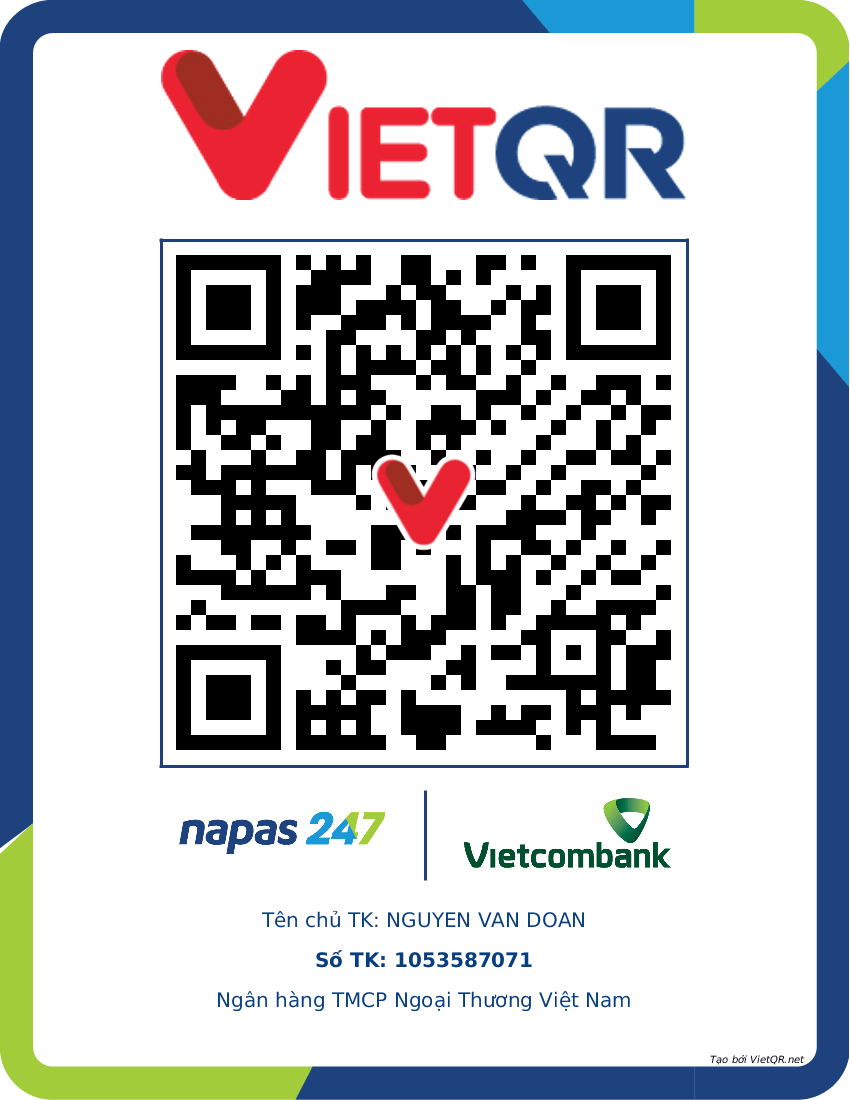Date of planning:…………..
Peroid 27 : UNIT 4: MY NEIGHBOURHOOD
Date of teaching: ………..…
Lesson 1: GETTING STARTED WEEK: … LOST IN THE OLD TOWN! THIS UNIT INCLUDES: Vocabulary Skills: - Places in a neighbourhood
- Reading about a neighbourhood Pronunciation:
- Talking about a neighbourhood
Pronunciation: Sounds: /I/and /i:/
- Listening about a neighbourhood Grammar
- Writing a paragragh to describe a neighbourhood
- Comparative adjectives: smaller; more Everyday English expensive
Asking for and giving directions I. OBJECTIVES:
* By the end of this unit, students will be able to: (Over all)
- use the words for places in a neighbourhood;
- pronounce the sounds /I/and /i:/ correctly;
- compare two people or things using comparative adjectives;
- ask for and give directions to some places;
- read for specific information about a neighbourhood; - talk about a neighbourhood;
- listen for specific information about a neighbourhood;
- write a paragraph to describe a neighbourhood. 1. Knowledge:
- To introduce topic of the lesson My neighbourhood. To teach listening and reading. Practice giving directions.
+ Vocabulary: - Use the words related to the topic My neighbourhood
- To pronounce the sounds /I/and /i:/ correctly;
+ Grammar: - compare two people or things using comparative adjectives; - Asking for directions
2. Competece: By the end of the lesson students will be able to pratice reading and listening the
conversation between Nick, Phong and Khang . They have arrived in Hoi An and they’ve got lost on their way to tan Ky House.
3. Quality/ behavior : The love of the neighbourhood, the hometown and the country. The likes
and dislikes their neighbourhoods. Having the serious attitude to asking and giving the directions;
cooperative learning; sharing. II. TEACHING AIDS:
- Teacher: Text book, laptop, louspeaker, projector… - Students : Text books, ….
- Method;: T-WC; group works; individual …… III. PROCEDURE:
1. WARM UP & INTRODUCTION (3’-5’)
Aims: To create an active atmosphere in the class before the lesson;
To lead into the new unit.
* Content: Having some warm-up activities to creat a friendly and relaxed atmostphere to inspire Ss to warm up to the new lesson.
* Outcome: Having a chance to speak English.
* Organisation : Teacher’s instructions….
Teacher’s & Student’s activities Content + Greeting + Greeting + Chatting + Chatting
- Teacher (T) asks Ss some questions about the
- Students (Ss) listen and learn how to do it . previous lessons,
- Review the previous unit before Ss open their
- Answer the teacher’s questions and
books. Organise a short vocabulary game to revise enquirements.
the words Ss learnt in Unit 3. For example, T can
organise Alphabet Race (read page 41 for the steps
+ Students (Ss) listen and learn how to do the
to play the game) or Slap the Board. tasks.
- Lead to the new unit. Write the unit title My
neighbourhood on the board. Ask Ss to guess what
they are going to learn about in this unit. After Ss
give the answers, ask them to open their books to
page 38. Draw their attention to the box and
introduce what they are going to learn in this unit.
- Write the unit title My neighbourhood on the
- Open their book and write . board.
2. PRESENTATION/ NEW LESSON ( 12’) ACTIVITY 1:
Aims: To set the context for the introductory text;
To introduce the topic of the unit.
* Content: Listen and read conversation to get used to the vocabulary; new grammar points.
* Outcome: Know more new words. Understanding the conversation; topic of the lesson, grammar points…
* Organisation : Teacher’s instructions….…
Teacher’s & Student’s activities Content 1. Listen and read. 1. Listen and read.
- Set the context for the listening and reading. - T_ Ss
Introduce Nick, Phong and Khang. Have Ss look at
the picture and answer some questions, e.g. What
are Nick, Phong and Khang doing? What might be
happening to them ? T can also ask Ss to share any
recent experiences of being lost, e.g. Have you ever
got lost? Where and when? How did you feel then?
What did you do? Elicit answers, but do not
confirm whether their answers are right or wrong.
- Ask Ss to talk a bit about the place where Nick, Phong and Khang are standing.
- Play the recording twice for Ss to listen and read
along. Have Ss underline the words that are related
to the topic of the unit while they are listening and reading.
Invite some Ss to read the conversation aloud.
- Ask Ss what exactly is happening to Nick, Phong
and Khang. Now confirm the correct answer. (They
have arrived in Hoi An and they've got lost on their way to Tan Ky House.)
- Have Ss say the words in the text that they think
are related to the topic My neighbourhood.
*) Pre- teach vocabulary:
- Listen carefully to the context
- Teacher uses different techniques to teach * Vocabulary
vocabulary (situation, realia, translation .....)
- excited (adj) phấn khích
+ Follow the steps to teach vocabulary
- cross (v) đi qua
- Repeat in chorus and individually
- famous (adj) nồi tiếng + Check cocabulary
- turn left >< turn right rẽ phải - Take note all the new words
- to be lost (v) bị lạc
- Quickly write the words on one part of the board.
- go straight (v) đi thẳng - Comment on Ss'answers. - …. 3. PRACTICE ( 15’) ACTIVITY 2:
Aim: To help Ss know how to use let's and shall we to make suggestions.
* Content: Make suggestions. We can use : Shall we…./ Let’s …. to make suggestions
* Outcome: Know how to make suggestions.
* Organisation : Teacher’s instructions…
Teacher’s & Student’s activities Content
2. Find in the conversation the sentences used to
2. Find in the conversation the sentences make suggestions.
used to make suggestions.
- Tell Ss to refer back to the conversation to find - T_ Ss
the sentences used to make suggestions.
- Listen carefully to the instructions
- Ask Ss to compare their answers before checking
- Follow the teacher’s instructions as a class.
Tell them to practise saying the sentences in pairs - Give the answers and check.
(play the recording again as a model if necessary). Key:
1. Let's go to Chua Cau.
- Confirm the correct answers.
2. Shall we go there first?
- Call on Ss to give the answers
3. First, cross the road, and then turn left.
- T gives the correct answers. 4. Fine, let's go. 5. Let's ask her. ACTIVITY 3:
Aim: To help Ss deeply understand the text.
* Content: Read conversation again . Put the actions in order
* Outcome: Order the actions correctly .
* Organisation : Teacher’s instructions…
Teacher’s & Student’s activities Content
3. Read the conversation again. Put the actions
3. Read the conversation again. Put the in order. actions in order.
- Ask Ss to work independently to order the actions - Ss_ Ss
in sentences (a - e) as they occur in the
- Listen to the instructions clearly conversation. - Share the answers
- T may instruct them how to do the exercise: (1) - Copy them
read each sentence and refer back to
the conversation to find the action it refers to; (2)
order the actions. T may model using the first sentence. Key :
- Allow Ss to share answers before discussing as a
1.b 2. c 3.d 4. e 5. a class.
- Write the correct answers on the board.
- Allow Ss to share answers before discussing as a
class. Write the correct answers on the board. - T gives correct answer ACTIVITY 4:
Aim: To help Ss know how to give directions through the conversation
* Content: Find and underline the directions . Asking for and giving directions
* Outcome: Know how to give directions. Can you tell me the way to the post office near here?..
* Organisation : Teacher’s instructions…...
4. Find and underline the following directions in 4. Find and underline the following the conversation.
directions in the conversation.
– Ask Ss to work individually to find and underline - T_ Ss
the phrases used to give directions in the
- Listen carefully and learn how to do.
conversation. T may move around the class to
check if Ss do exactly what is required and offer
- Ss do themselves. Give the answers help when needed.
- Have Ss quickly match each direction with the
diagram. Check their answers as a class. If ss do not
understand the phrases, use the diagrams to work Key:
the meaning out from the context. For weak classes, 1. B 2. A 3. E 4.C 5. D
ask for translation to make sure they understand.
With stronger classes, T may wish to ask some
additional questions, e.g. Can you tell me the way
to the post office near here?, etc.
4. PRODUCTION/ APPLICATION ( 8’) ACTIVITY 5:
Aim: To help Ss practise giving directions.
* Content: Practise giving directions.Playing Game. Find places
* Outcome: Give directions correctly.
* Organisation : Teacher’s instructions…...
Teacher’s & Student’s activities Content
Giáo án Unit 4: My neighbourhood Tiếng Anh 6 Global success
1 K
476 lượt tải
MUA NGAY ĐỂ XEM TOÀN BỘ TÀI LIỆU
CÁCH MUA:
- B1: Gửi phí vào TK:
1133836868- CT TNHH DAU TU VA DV GD VIETJACK - Ngân hàng MB (QR) - B2: Nhắn tin tới Zalo VietJack Official ( nhấn vào đây ) để xác nhận thanh toán và tải tài liệu - giáo án
Liên hệ ngay Hotline hỗ trợ: 084 283 45 85
Bộ giáo án Tiếng anh 6 Global success được cập nhật liên tục trong gói này từ nay đến hết tháng 3/2024.
Để tải tài liệu gốc về máy bạn click vào nút Tải Xuống ở trên!
Thuộc bộ (mua theo bộ để tiết kiệm hơn):
- Bộ giáo án Tiếng anh 6 Global success năm 2023 mới, chuẩn nhất được thiết kế theo phong cách hiện đại, đẹp mắt, trình bày chi tiết cho từng bài học và bám sát chương trình Sách giáo khoa Tiếng anh 6 Global success.
- Mua trọn bộ sẽ tiết kiệm hơn tải lẻ 50%.
Đánh giá
4.6 / 5(952 )5
4
3
2
1
Trọng Bình
Tài liệu hay
Giúp ích cho tôi rất nhiều
Duy Trần
Tài liệu chuẩn
Rất thích tài liệu bên VJ soạn (bám sát chương trình dạy)
TÀI LIỆU BỘ BÁN CHẠY MÔN Tiếng Anh
Xem thêmTÀI LIỆU BỘ BÁN CHẠY Lớp 6
Xem thêmTài liệu bộ mới nhất

Date of planning:…………..
Date of teaching: ………..…
WEEK: …
Peroid 27 : UNIT 4: MY NEIGHBOURHOOD
Lesson 1: GETTING STARTED
LOST IN THE OLD TOWN!
THIS UNIT INCLUDES:
Vocabulary
- Places in a neighbourhood
Pronunciation:
Pronunciation: Sounds: /I/and /i:/
Grammar
- Comparative adjectives: smaller; more
expensive
Skills:
- Reading about a neighbourhood
- Talking about a neighbourhood
- Listening about a neighbourhood
- Writing a paragragh to describe a neighbourhood
Everyday English
Asking for and giving directions
I. OBJECTIVES:
* By the end of this unit, students will be able to: (Over all)
- use the words for places in a neighbourhood;
- pronounce the sounds /I/and /i:/ correctly;
- compare two people or things using comparative adjectives;
- ask for and give directions to some places;
- read for specific information about a neighbourhood;
- talk about a neighbourhood;
- listen for specific information about a neighbourhood;
- write a paragraph to describe a neighbourhood.
1. Knowledge:
- To introduce topic of the lesson My neighbourhood. To teach listening and reading. Practice giving
directions.
+ Vocabulary: - Use the words related to the topic My neighbourhood
- To pronounce the sounds /I/and /i:/ correctly;
+ Grammar: - compare two people or things using comparative adjectives;
- Asking for directions
2. Competece: By the end of the lesson students will be able to pratice reading and listening the
conversation between Nick, Phong and Khang . They have arrived in Hoi An and they’ve got lost on
their way to tan Ky House.
3. Quality/ behavior : The love of the neighbourhood, the hometown and the country. The likes
and dislikes their neighbourhoods. Having the serious attitude to asking and giving the directions;
cooperative learning; sharing.
II. TEACHING AIDS:
- Teacher: Text book, laptop, louspeaker, projector…
- Students : Text books, ….
- Method;: T-WC; group works; individual ……
III. PROCEDURE:
1. WARM UP & INTRODUCTION (3’-5’)
Aims: To create an active atmosphere in the class before the lesson;
To lead into the new unit.

* Content: Having some warm-up activities to creat a friendly and relaxed atmostphere to inspire Ss
to warm up to the new lesson.
* Outcome: Having a chance to speak English.
* Organisation : Teacher’s instructions….
Teacher’s & Student’s activities
Content
+ Greeting
+ Chatting
- Teacher (T) asks Ss some questions about the
previous lessons,
- Review the previous unit before Ss open their
books. Organise a short vocabulary game to revise
the words Ss learnt in Unit 3. For example, T can
organise Alphabet Race (read page 41 for the steps
to play the game) or Slap the Board.
- Lead to the new unit. Write the unit title My
neighbourhood on the board. Ask Ss to guess what
they are going to learn about in this unit. After Ss
give the answers, ask them to open their books to
page 38. Draw their attention to the box and
introduce what they are going to learn in this unit.
- Write the unit title My neighbourhood on the
board.
+ Greeting
+ Chatting
- Students (Ss) listen and learn how to do it .
- Answer the teacher’s questions and
enquirements.
+ Students (Ss) listen and learn how to do the
tasks.
- Open their book and write .
2. PRESENTATION/ NEW LESSON ( 12’)
ACTIVITY 1:
Aims: To set the context for the introductory text;
To introduce the topic of the unit.
* Content: Listen and read conversation to get used to the vocabulary; new grammar points.
* Outcome: Know more new words. Understanding the conversation; topic of the lesson, grammar
points…
* Organisation : Teacher’s instructions….…
Teacher’s & Student’s activities
Content
1. Listen and read.
- Set the context for the listening and reading.
Introduce Nick, Phong and Khang. Have Ss look at
the picture and answer some questions, e.g. What
are Nick, Phong and Khang doing? What might be
happening to them ? T can also ask Ss to share any
recent experiences of being lost, e.g. Have you ever
got lost? Where and when? How did you feel then?
What did you do? Elicit answers, but do not
confirm whether their answers are right or wrong.
- Ask Ss to talk a bit about the place where Nick,
Phong and Khang are standing.
- Play the recording twice for Ss to listen and read
1. Listen and read.
- T_ Ss

along. Have Ss underline the words that are related
to the topic of the unit while they are listening and
reading.
Invite some Ss to read the conversation aloud.
- Ask Ss what exactly is happening to Nick, Phong
and Khang. Now confirm the correct answer. (They
have arrived in Hoi An and they've got lost on their
way to Tan Ky House.)
- Have Ss say the words in the text that they think
are related to the topic My neighbourhood.
*) Pre- teach vocabulary:
- Teacher uses different techniques to teach
vocabulary (situation, realia, translation .....)
+ Follow the steps to teach vocabulary
- Repeat in chorus and individually
+ Check cocabulary
- Take note all the new words
- Quickly write the words on one part of the board.
- Comment on Ss'answers.
- Listen carefully to the context
* Vocabulary
- excited (adj) phấn khích
- cross (v) đi qua
- famous (adj) nồi tiếng
- turn left >< turn right rẽ phải
- to be lost (v) bị lạc
- go straight (v) đi thẳng
- ….
3. PRACTICE ( 15’)
ACTIVITY 2:
Aim: To help Ss know how to use let's and shall we to make suggestions.
* Content: Make suggestions. We can use : Shall we…./ Let’s …. to make suggestions
* Outcome: Know how to make suggestions.
* Organisation : Teacher’s instructions…
Teacher’s & Student’s activities
Content
2. Find in the conversation the sentences used to
make suggestions.
- Tell Ss to refer back to the conversation to find
the sentences used to make suggestions.
- Ask Ss to compare their answers before checking
as a class.
Tell them to practise saying the sentences in pairs
(play the recording again as a model if necessary).
- Confirm the correct answers.
- Call on Ss to give the answers
- T gives the correct answers.
2. Find in the conversation the sentences
used to make suggestions.
- T_ Ss
- Listen carefully to the instructions
- Follow the teacher’s instructions
- Give the answers and check.
Key:
1. Let's go to Chua Cau.
2. Shall we go there first?
3. First, cross the road, and then turn left.
4. Fine, let's go.
5. Let's ask her.
ACTIVITY 3:
Aim: To help Ss deeply understand the text.
* Content: Read conversation again . Put the actions in order
* Outcome: Order the actions correctly .
* Organisation : Teacher’s instructions…

Teacher’s & Student’s activities
Content
3. Read the conversation again. Put the actions
in order.
- Ask Ss to work independently to order the actions
in sentences (a - e) as they occur in the
conversation.
- T may instruct them how to do the exercise: (1)
read each sentence and refer back to
the conversation to find the action it refers to; (2)
order the actions. T may model using the first
sentence.
- Allow Ss to share answers before discussing as a
class.
- Write the correct answers on the board.
- Allow Ss to share answers before discussing as a
class. Write the correct answers on the board.
- T gives correct answer
3. Read the conversation again. Put the
actions in order.
- Ss_ Ss
- Listen to the instructions clearly
- Share the answers
- Copy them
Key :
1.b 2. c 3.d 4. e 5. a
ACTIVITY 4:
Aim: To help Ss know how to give directions through the conversation
* Content: Find and underline the directions . Asking for and giving directions
* Outcome: Know how to give directions. Can you tell me the way to the post office near here?..
* Organisation : Teacher’s instructions…...
4. Find and underline the following directions in
the conversation.
– Ask Ss to work individually to find and underline
the phrases used to give directions in the
conversation. T may move around the class to
check if Ss do exactly what is required and offer
help when needed.
- Have Ss quickly match each direction with the
diagram. Check their answers as a class. If ss do not
understand the phrases, use the diagrams to work
the meaning out from the context. For weak classes,
ask for translation to make sure they understand.
With stronger classes, T may wish to ask some
additional questions, e.g. Can you tell me the way
to the post office near here?, etc.
4. Find and underline the following
directions in the conversation.
- T_ Ss
- Listen carefully and learn how to do.
- Ss do themselves. Give the answers
Key:
1. B 2. A 3. E 4.C 5. D
4. PRODUCTION/ APPLICATION ( 8’)
ACTIVITY 5:
Aim: To help Ss practise giving directions.
* Content: Practise giving directions.Playing Game. Find places
* Outcome: Give directions correctly.
* Organisation : Teacher’s instructions…...
Teacher’s & Student’s activities
Content

5. GAME- Find places
– Demonstrate the game with a strong student.
– Ask Ss to play the game in pairs. In weaker
classes, work together with Ss first: asking about
one or two different places on the map and eliciting
the answers. Then when they know exactly what to
do, ask them to work in pairs. T may go around to
observe and offer help if necessary.
– Invite some pairs to perform in front of the class.
This activity can be organised as a competition
game. The class is divided into teams A and B.
Team A give directions and Team B guess the
place. If their guess is correct, they get one point.
Then change roles. The group with the most points
is the winner.
5. GAME- Find Places
- T_ Ss
- Listen to the instructions carefully then do
the tasks.
- Ask and answer
5. WRAP-UP & HOME WORK (2’)
– Ask one or two Ss to tell the class what they have learnt.
– Ask Ss to say aloud some words they remember from the lesson. If there is an overhead projector
in the classroom, show the dialogue, highlight the key words related to the topic. It would be helpful
if T also highlights in the dialogue the comparative adjectives and phrases of giving directions and
tells Ss that they will learn these language points in the following lessons
- Ask Ss to say aloud some words they remember from the lesson.
* HOMEWORK
- Read again the conversation on page 6.
- Do more exercises in workbook.
- Prepare new lessons.
=====================
